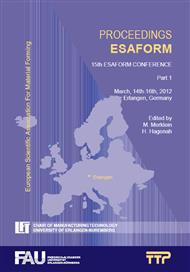p.47
p.53
p.59
p.65
p.71
p.77
p.83
p.89
p.95
Influence of Different Pre-Stretching Modes on the Forming Limit Diagram of AA6014
Abstract:
In order to evaluate the formability of sheet materials forming limit diagrams (FLD) are recorded which represent the values of major and minor strain when necking occurs. FLDs are recorded based on the assumption that exclusively linear strain paths occur. In real forming parts, however, particularly in those with complex shapes, predominantly non-linear strain paths occur which reduce the accuracy of the failure prediction according to a conventional FLD. For this reason forming limits after loading with non-linear strain paths have to be investigated. In this contribution a systematic analysis of the forming limits of a conventional AA6014 alloy after loading with non-linear strain paths is presented. This material is pre-stretched in uniaxial, plane strain and biaxial direction up to several levels before performing Nakajima experiments in order to determine FLDs. During the pre-stretching process as well as during the Nakajima experiment the strain distribution can be measured online very precisely with the optical deformation measurement systems GOM Aramis or VIALUX. The gained curves are compared to the FLD of the as-received material. The results prove a significant influence of the pre-stretching condition on the forming limits of the used aluminum alloy. For a low pre-stretching in uniaxial as well as in biaxial direction the FLDs show a slightly reduced formability while after higher pre-stretching levels the forming limit can be improved such as for biaxial loading after uniaxial pre-stretching. The formability after pre-stretching in plane strain direction was changed. Also, a shift of the FLD depending on the direction of pre-stretching can be observed.
Info:
Periodical:
Pages:
71-76
Citation:
Online since:
February 2012
Keywords:
Price:
Сopyright:
© 2012 Trans Tech Publications Ltd. All Rights Reserved
Share:
Citation:


